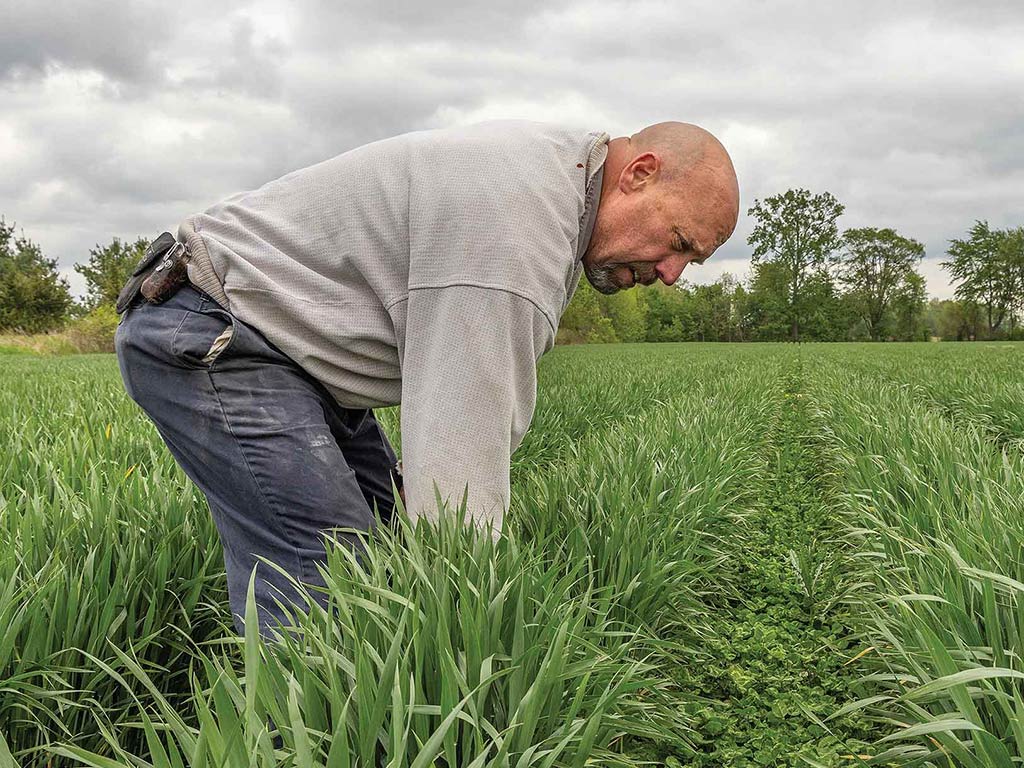
Winter canola starts flowering about May first in the southernmost parts of Ontario. Its brilliant yellow flowers stand out against the somber shades of the rest of the countryside. The fields are so stunning that locals jumped at a chance to take selfies with it in exchange for a small donation to the SSVP Harrow Food Bank.
Agriculture April 01, 2024
Enjoy the View
Canola gets a photo op.
by Lorne McClinton
Spotting winter canola in full flower is rapidly becoming a sure sign that spring has arrived in the Windsor-Essex region of far Southwest Ontario. The crop starts flowering in early May in the most southerly regions of the province when the contrast between a field of its brilliant yellow flowers and the somber shades of the rest of the countryside could hardly be more extreme. They stand out for miles.
The crop is just starting to catch on in the region. About 15,000 acres of it were grown there in 2023. It's not unusual to see one, but it's not a common sight either. So, Karl and Sandy Neudorf knew planting a field along Concession Road 3, near Harrow, Ontario, would attract a lot of attention.
They decided to set up a spot where the public would have the opportunity to take a selfie with their winter canola and his antique 1949 Ford Mercury truck in exchange for a donation to the local Society of St. Vincent de Paul (SSVP) Harrow Food Bank. After all, they reasoned, people were going to be stopping anyway so why not use it as an opportunity to raise money for charity and create some positive vibes.
Above. Rob and LouAnn Bigley drove from Leamington, Ontario, to see the field and take selfies. Karl and Sandy Neudorf's winter canola photo op fundraiser raised $5,000 for the local SSVP Harrow Food Bank.
A huge success. The couple's first-time fundraiser succeeded far better than they ever dreamed. All together they raised $5,000 for the local charity. Just under half the total, $2,200, came from a raffle of a print of the scene taken by local photographer Donnie Moore. A local tile drainage contractor donated another $750, but the rest came from hundreds of five-, ten-, and twenty-dollar bills left in a donation box bolted to the truck bed.
Locals started stopping by to take pictures in droves almost as soon as the first blossoms started appearing around May first. By the time the local high school's prom rolled around two weeks later the field was in full flower.
"Girls used the field as a backdrop for photos of them in their prom dresses," Karl Neudorf says. "Couples staged their engagement and wedding photos here, too. There definitely were a lot of interesting people that stopped by. We found that the response was just overwhelming, it shows there are lots of generous people living in our community."
By mid-month news of the winter canola photo op started to spread beyond the immediate area. After it received radio and television coverage from stations in nearby Windsor, the spot became locally famous. People made the half-hour drive from Leamington and others came from as far away as Windsor. One of the Windsor radio stations started calling him Canola Karl, Neudorf says. The name seems to have stuck.
Winter canola has been a huge crop in northern European countries for decades. Ontario farmers have experimented with it on and off over the years with mixed results. However, the release of high-yielding new varieties combined with the possibility of double cropping short season soybeans afterwards has caused interest to surge.
The crop is planted in September and overwinters as a taproot in the four-leaf stage, so it provides good soil cover over the winter. It gets an early jump on the weeds in the spring; it's a very competitive crop. It shoots up in the spring and quickly canopies over the rows. Weed control is rarely an issue. Typically, farmers dessicate the crop just prior to harvest so it's ready to be combined about the same time as their winter wheat.
"I grow the traditional crops, corn, wheat, and soybeans," Neudorf says. "It's planted in September and if it can be harvested before the winter wheat is ready to go, it'll spread out the workload. This year (2023) was just my third attempt at growing canola and I still have a lot more to learn about its agronomy. It yielded 74 bushels to the acre which I understand is quite good."
Even though most farmers discourage the public from going into fields Neudorf says setting up the selfie photo op was definitely a positive experience. The public was very respectful, there was no evidence of anyone trampling his crop and there was never any evidence of theft.
"I will have canola fields in that area in 2024 but I'm not planning on hosting another selfie photo op," Neudorf says. "I think the novelty of it was a big part of the reason for the success we had in 2023 and I don't think I'd get that level of interest again. I don't want it to get old, I'd rather go out on a high note." ‡
Read More

AGRICULTURE, SUSTAINABILITY
Moving into the Mainstream
Will strip till's time ever come?



